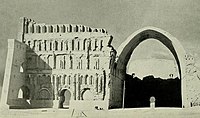Chaldean Catholic Eparchy of Mardin
This article needs additional citations for verification. (April 2014) |
Background

Fiey’s list of the
The Chaldean diocese of Mardin appears to have been founded in the second half of the sixteenth-century, either by
This list is of very doubtful authenticity. Firstly, although some of its names are plausible, it is surprising to find
In the literary sources Mardin appears three times[
The metropolitan Ishoʿyahb of Nisibis, a supporter of Shemʿon VII Isho‘yahb and his successor Eliya VI (1558-1591), is styled 'metropolitan of Nisibis, Mardin, Amid and all Armenia' in a colophon of 1554, and 'metropolitan of Nisibis, Mardin and Armenia' in colophons of 1558 and 1560. The earlier title may have been intended to challenge the authority of Sulaqa's metropolitan Eliya of Amid, and both styles may be evidence that Mardin was at this period loyal to Shemʿon VII Ishoʿyahb and did not yet have its own bishop.
The Chaldean bishops of Mardin
This reference is of some interest. The first indisputable
Hnanishoʿ was one of the signatories of a letter of 1580 from the fourth Catholic patriarch Shemʿon IX Denha to pope Gregory XIII. In 1582, he visited Jerusalem, where he celebrated the feast of the Resurrection on 15 April. He completed a copy of a manuscript at Mardin on 10 December 1586, and was not among the metropolitans who witnessed the profession of faith of Eliya VI at Alqosh a fortnight later on 23 December 1586. An archbishop Hnanishoʿ 'of Mansuriya', probably the same man, is included in Leonard Abel's 1587 list of 'the most literate men in the Nestorian nation'.
Hnanishoʿ may have died shortly afterwards. Thereafter, until 1615, Mardin appears to have been under the jurisdiction of Yaʿqob, metropolitan of Nisibis. Yaʿqob is mentioned in the report of 1607 as 'metropolitan of Mardin', and in 1614 is styled 'metropolitan of Nisibis and Mardin' in a letter of Peter Strozza.
According to Tfinkdji, the next three seventeenth-century metropolitans of Mardin were Yohannan (1615–41), Joseph (1641–78), and Shemʿon of Amid (1682–95). The source for some of these dates is not clear, and the evidence from the dating formulas of manuscripts is contradictory. The title of Timothy, metropolitan of Amid between 1615 and his death in 1621/2, also included Mardin, suggesting that Yohannan's reign began in 1622 or later. The metropolitan Yohannan of Mardin, said by Tfinkdji to have died in Nisibis in 1641, is mentioned in the dating formulas of manuscripts of 1635 and 1645. The name and (presumably incorrect) reign-dates of the metropolitan Joseph were contained in a note in an East Syriac manuscript copied in 1679 and seen by Tfinkji in a Jacobite church. Shemʿon of Amid is said to have been consecrated by Joseph I, and to have died at Mardin in 1695.
According to Tfinkdji
The bishop Basil Hesro of Mardin was one of three bishops (with Basil of Amid and Shemʿon of Seert) consecrated by
Basil Hesro was succeeded shortly after his death by the priest Yohannan of Mardin, who was consecrated by Joseph III and also took the name Basil in honour of his predecessor (Tfinkdji). He cannot have been consecrated in 1738, as Tfinkdji stated, as Joseph III only returned to Amid at the end of 1741. He is probably to be identified with the 95-year-old metropolitan of Mardin mentioned by Cardinal Tamburini at the beginning of 1757 as the sole surviving Catholic bishop in the Amid patriarchate (following the recent deaths of the patriarch Joseph III and the metropolitan Timothy Masaji of Amid). He consecrated
Yohannan was succeeded by the metropolitan Shemʿon of Amid, apparently consecrated by Joseph III in 1758. In 1782, he intervened to secure protection for the Syriac Catholic patriarch Michael III Jarweh, who was persecuted by the Jacobites of Mardin after his conversion to Catholicism. According to his epitaph, he died on 19 November 1788.
Shemʿon was succeeded in 1795 by the priest Mikha'il Shawriz of Seert, the brother of the metropolitan Peter Shawriz of Seert. According to the patriarch
All this time I had received no letters from Diarbekir or Mardeen, for it appears that they would not receive the orders of our lord the Pope; on the contrary, Kasha Agostîn went to Sert, where there was a presbyter named Michael. Him he took to one of the Tcawâlakha [Jilu] Metropolitans and got him consecrated Metropolitan, and set him over Mardeen without the consent of our lord the Pope.[2]
Because of the irregularity of his consecration, Mikha'il was excommunicated by the Vatican but was absolved by pope Pius VI in 1795 and confirmed as bishop of Mardin. Tfinkdji, followed by Fiey, gives the date of his death as 3 April 1810.
Mikha'il was succeeded by Ignatius Dashto of
Mar Yoosef took upon himself to send Mutran Michael to Sert, and Mutran Ignatius to Mardeen, though this latter town had been placed under the jurisdiction of Mutran Hanna by the Pope himself.[3]
Ignatius Dashto was succeeded by Gabriel Farso, who was consecrated in 1870 and died on 27 June 1873. He was succeeded by Peter Timothy ʿAttar, who was consecrated metropolitan of Amid in 1870 and transferred to Mardin in 1873 on Farso's premature death. He died on 1 November 1891, but seems to have been succeeded as metropolitan of Mardin some years before his death by Yohannan Eliya Mellus, c.1887–1908.
A number of manuscripts in the Mardin collection, some of which were later donated to the Vatican, formed part of the personal collection of the metropolitan Yohannan Eliya Mellus in the 1880s.
In 1910,
Population
The modern day Chaldean population of Mardin is said to include only one family, and they hold the key to the Chaldean Catholic Church of Mardin, which is still maintained but inactive. The Church is now under the control of the Chaldean Catholic Archeparchy of Amida.
Historic censuses
In 1842, the diocese of Mardin consisted only of the town itself, which had a church, four priests, and 60 Chaldean families (Badger). In 1852 the diocese of Mardin and Nisibis contained 500 Chaldeans (Marchi). In 1867, the diocese contained 2 villages and had a population of 1,000 Chaldeans, served by 2 priests (Martin).
In 1896, the diocese of Mardin had 850 Chaldeans, with a parish for Mardin itself, and four stations, one of which was near Nisibis (Chabot). There were then 3 priests, assisted by a Capuchin house in the diocese.
In 1913, the diocese of Mardin consisted of 1,670 believers, with 6 priests, a church, 2 chapels, 3 schools, and 2 mission stations (Tfinkdji). The majority lived in
In 2005 the Chaldean Catholic Church was reopened, and served 5 Chaldean families. Due to the absence of a Chaldean Catholic priest, the church is managed by a local Syriac Orthodox priest.[4]
Notes and references
- ^ Fiey, POCN, 107–8; Tfinkdji, EC, 505–11; Wilmshurst, EOCE, 72–5
- ^ Badger, Nestorians, i. 158
- ^ Badger, Nestorians, i. 158
- ^ "Ancient Chaldean Church reopened in Turkey. MGR. Warduni "Sign of unity"". Archived from the original on 2017-02-02. Retrieved 2016-07-17.
Sources and external links
- Baaba, Youel A. (2009). The Assyrian Homeland before World War I. Alamo, California. ISBN 978-0-9707489-6-6.)
{{cite book}}: CS1 maint: location missing publisher (link - Badger, George Percy (1852). The Nestorians and Their Rituals. Vol. 1. London: Joseph Masters.
- ISBN 9780790544823.
- Chabot, Jean-Baptiste (1896). "Éttat religieux des diocèses formant le patriarcat chaldéen de Babylone". Revue de l'Orient chrétien. 1: 433-453.
- Fiey, J.M. (1962). Assyrie chrétienne (3 vols). Beirut.
{{cite book}}: CS1 maint: location missing publisher (link) - ISBN 9783515057189.
- Giamil, Samuel (1902). Genuinae relationes inter Sedem Apostolicam et Assyriorum orientalium seu Chaldaeorum ecclesiam. Roma: Ermanno Loescher.
- Martin, Jean Pierre Paulin (1867). La Chaldée, esquisse historique, suivie de quelques réflexions sur l'Orient. Rome: Imprimerie de la Civiltà Cattolica.
- Tfinkdji, J. (1914). "L'église chaldéenne catholique autrefois et aujourd'hui". Annuaire Pontifical Catholique (17): 449–525.
- Tisserant, Eugène (1931). "Église nestorienne". Dictionnaire de théologie catholique. Vol. 11. pp. 157–323.
- Wilmshurst, David (2000). The Ecclesiastical Organisation of the Church of the East, 1318–1913. Louvain: Peeters Publishers. ISBN 9789042908765.


